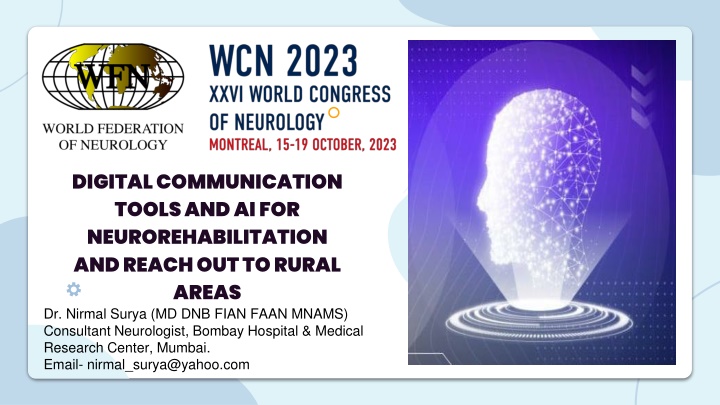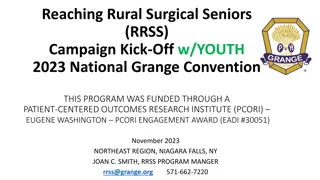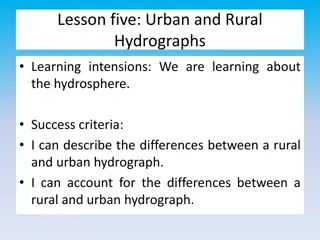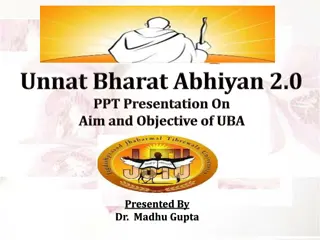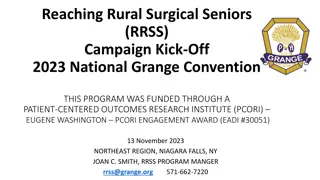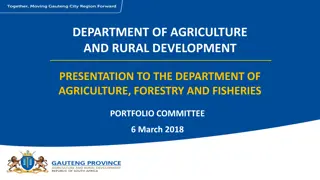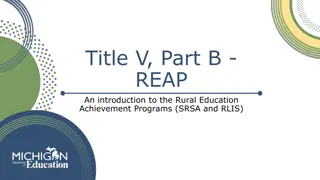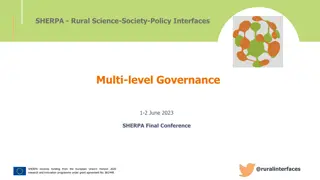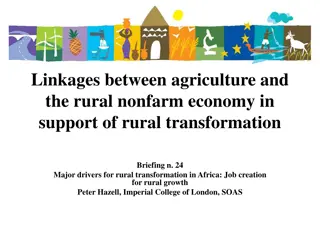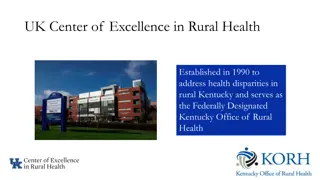Digital Communication Tools and AI for Neurorehabilitation in Rural Areas
Introduce the transformative potential of digital communication tools and AI in neurorehabilitation outreach to rural areas. Dr. Nirmal Surya, a Consultant Neurologist, emphasizes measurable outcomes through pre-lecture surveys and post-lecture quizzes. The lecture breaks down complex concepts, providing real-world examples to illustrate practical applications. Key message: Technology can bridge the gap in accessing neurorehabilitation services for underserved communities, empowering healthcare providers and improving patient outcomes.
Download Presentation

Please find below an Image/Link to download the presentation.
The content on the website is provided AS IS for your information and personal use only. It may not be sold, licensed, or shared on other websites without obtaining consent from the author.If you encounter any issues during the download, it is possible that the publisher has removed the file from their server.
You are allowed to download the files provided on this website for personal or commercial use, subject to the condition that they are used lawfully. All files are the property of their respective owners.
The content on the website is provided AS IS for your information and personal use only. It may not be sold, licensed, or shared on other websites without obtaining consent from the author.
E N D
Presentation Transcript
DIGITAL COMMUNICATION TOOLS AND AI FOR NEUROREHABILITATION AND REACH OUT TO RURAL AREAS Dr. Nirmal Surya (MD DNB FIAN FAAN MNAMS) Consultant Neurologist, Bombay Hospital & Medical Research Center, Mumbai. Email- nirmal_surya@yahoo.com
Disclosure Dr. Nirmal Surya has no disclosures or Conflict of Interest
Learning Objectives To introduce the audience to digital communication tools and artificial intelligence (AI) applications in neurorehabilitation. To ensure measurable outcomes, we will gauge the audience's understanding by using pre-lecture surveys to assess their baseline knowledge and post-lecture quizzes to evaluate their comprehension. To make the objectives achievable, we will break down complex concepts into digestible segments, providing real-world examples and case studies to illustrate the practical applications of digital tools and AI in neurorehabilitation. The objectives will focus on the relevance of digital communication tools and AI in addressing the specific challenges faced by rural areas in accessing neurorehabilitation services, making it pertinent to the audience's needs. The lecture will be designed to be completed within a specific timeframe to ensure that the content is presented effectively and that there is time for questions and discussions at the end.
Key Message Digital communication tools and artificial intelligence (AI) have the transformative potential to bridge the gap in neurorehabilitation services for rural areas. By harnessing the power of technology, we can enhance access to quality care, improve patient outcomes, and empower healthcare providers as well as family to reach even the most underserved communities.
References 1. Dobkin, B. H. (2018). Dosing, timing, and boosting of rehabilitation: why interventions may have different effects. The Scientific World Journal, 2018. - This paper discusses the role of technology in optimizing the delivery of neurorehabilitation and the importance of timing and dosage. 2. The Lancet Neurology. (2018). Stroke care and rehabilitation in rural China. The Lancet Neurology, 17(10), 831. - This article sheds light on the challenges of providing neurorehabilitation services in rural areas and potential solutions using digital tools. 3. Laver, K., Lange, B., George, S., Deutsch, J. E., Saposnik, G., & Crotty, M. (2017). Virtual reality for stroke rehabilitation. Cochrane Database of Systematic Reviews, 11(11) - A comprehensive review of studies on the use of virtual reality and digital tools in stroke rehabilitation. 4. Rural Health Information Hub. (2021). Telehealth Use in Rural Healthcare. - Offers insights into the use of telehealth and digital communication tools in rural healthcare settings.
5. Bashshur, R. L., Shannon, G. W., & Krupinski, E. A. (2016). The taxonomy of telemedicine. Telemedicine and e-Health, 22(9), 590-594. - Provides a taxonomy of telemedicine that helps explain the different applications of digital communication tools in healthcare. 6. World Health Organization. (2010). mHealth: New horizons for health through mobile technologies. - Discusses how mobile technologies, including AI, can improve healthcare delivery in resource-limited rural areas. 7. Dunn, J., Runge, R., Snyder, M., & Butts, A. (2017). Rural telehealth research center literature review. Rural Telehealth Research Center. - Offers a literature review on telehealth and its role in addressing healthcare disparities in rural areas.
